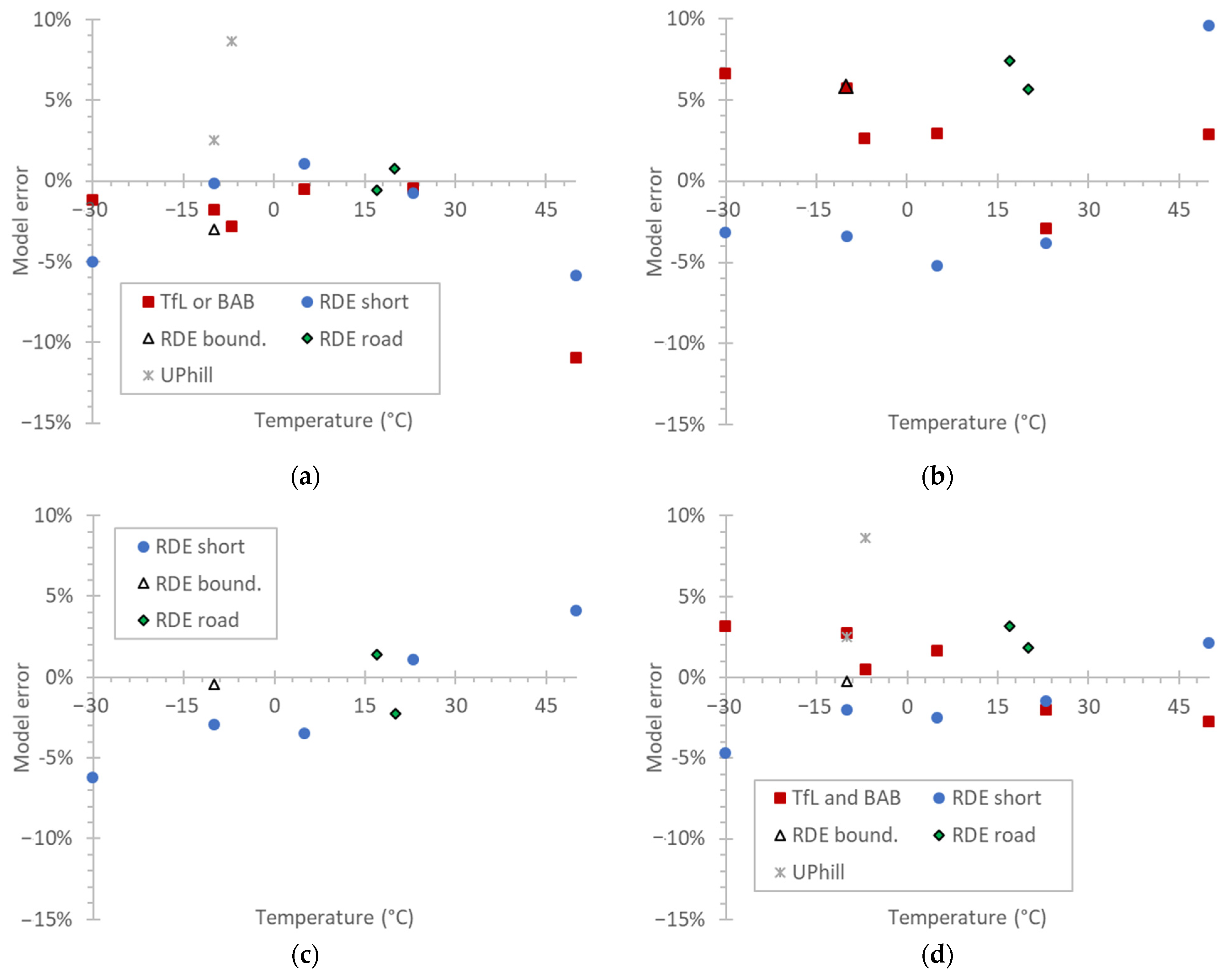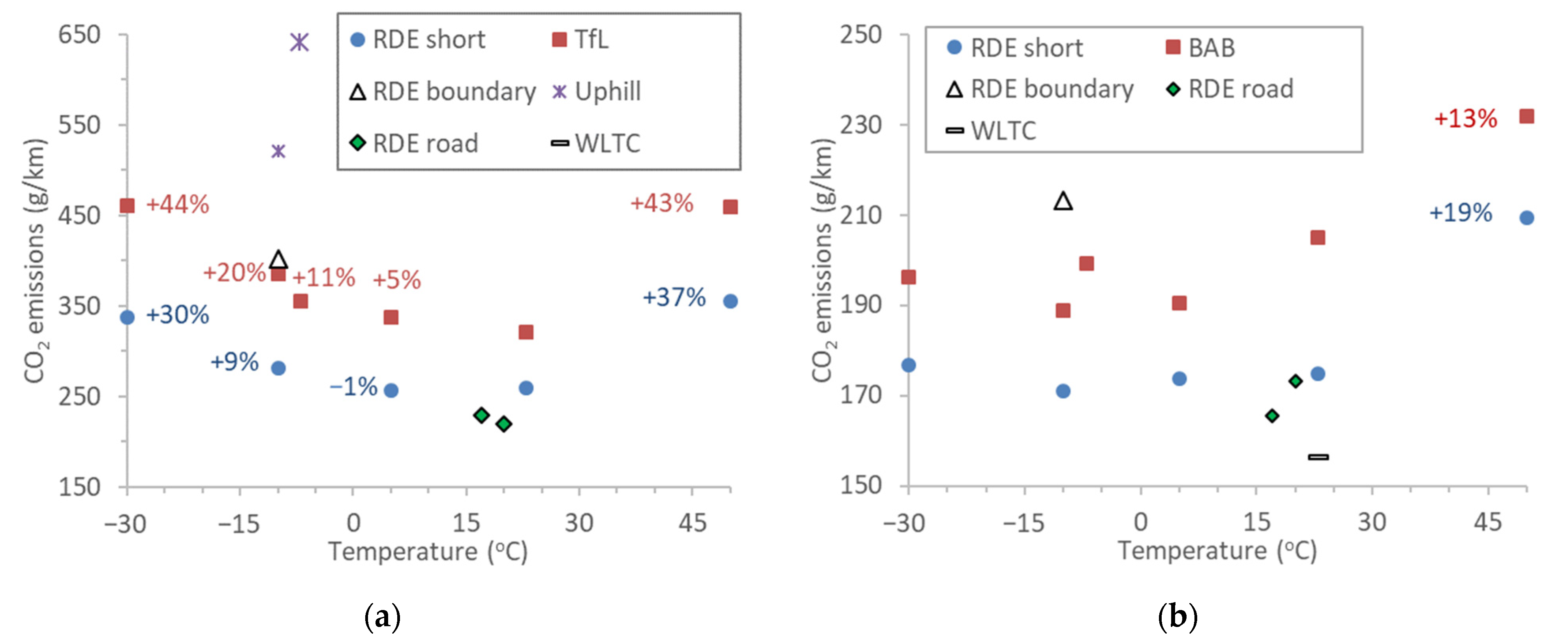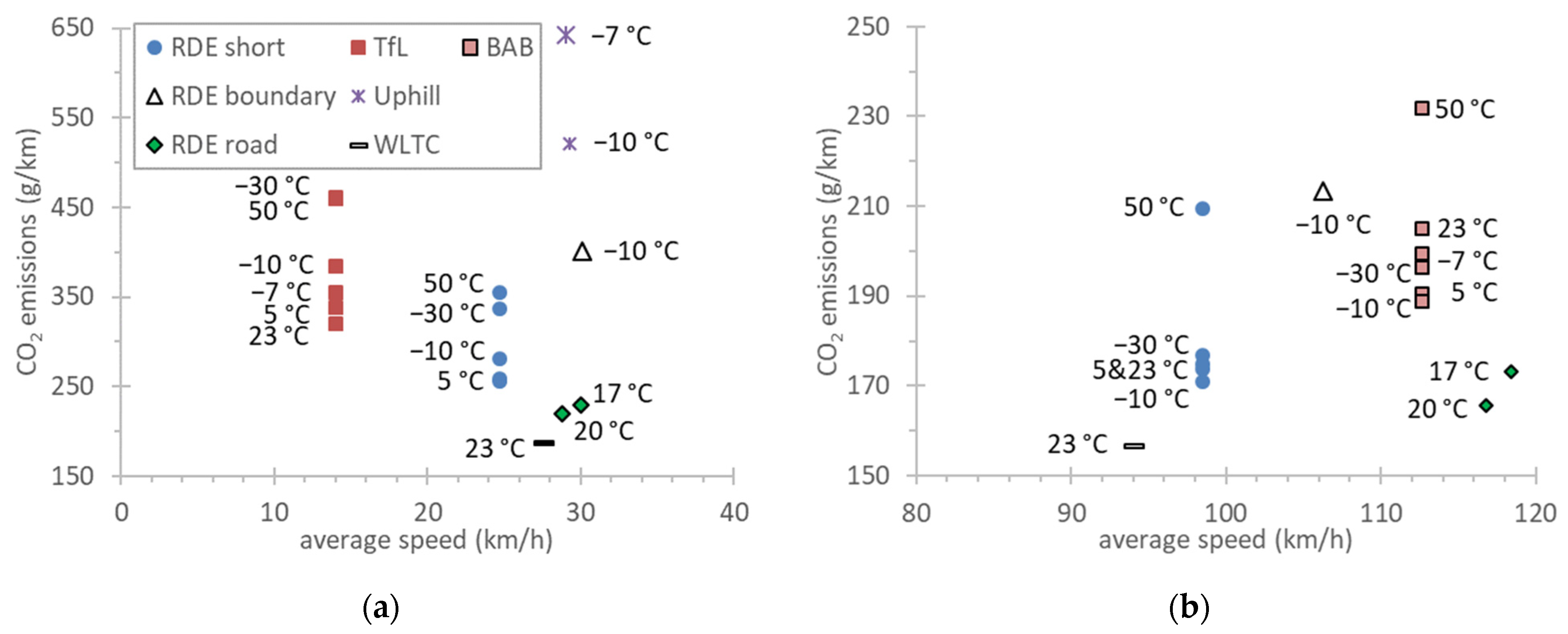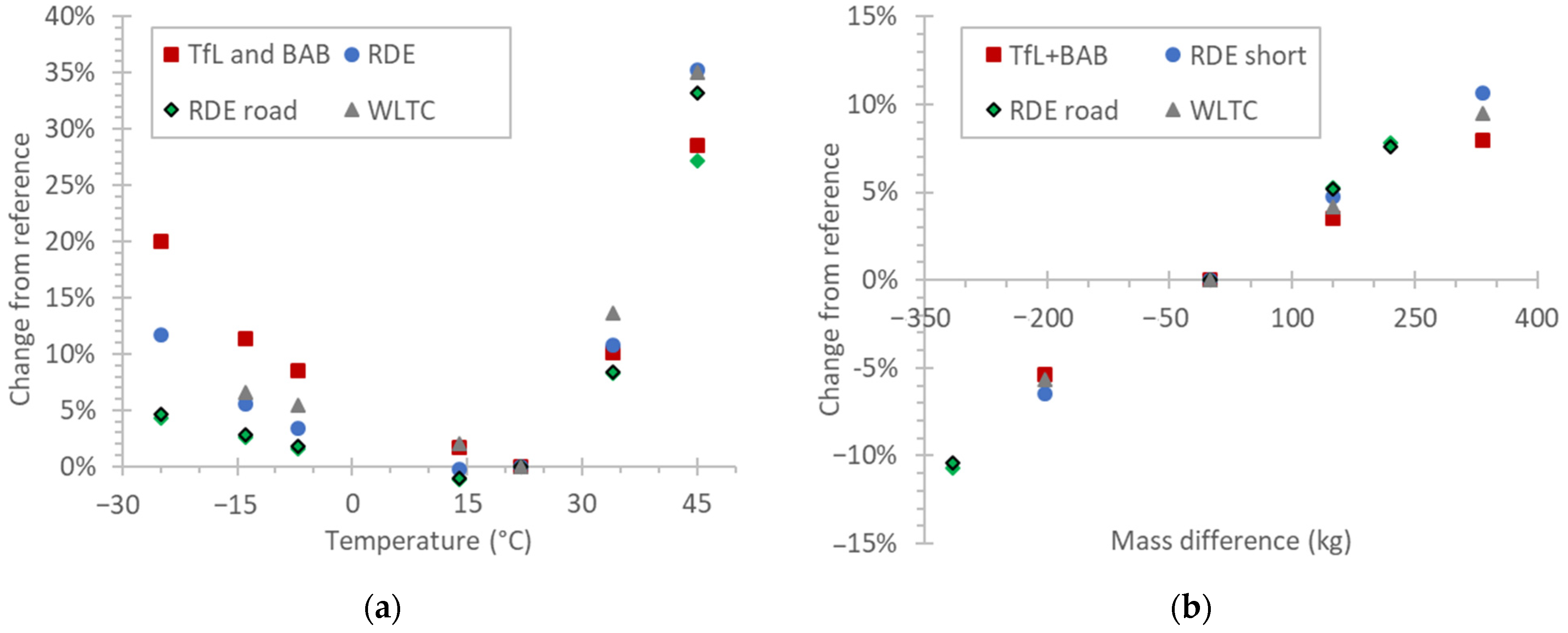Impacts of Extreme Ambient Temperatures and Road Gradient on Energy Consumption and CO2 Emissions of a Euro 6d-Temp Gasoline Vehicle
Abstract
1. Introduction
2. Materials and Methods
2.1. Experimental Setup, Vehicle, Cycles
2.2. Vehicle Simulation
2.3. Simulation Equations
3. Results
3.1. Real Time Example
3.2. Urban and Motorway Emissions
4. Discussion
4.1. Fuel Energy Shares
4.2. Sensitivity Analysis
5. Conclusions
Author Contributions
Funding
Institutional Review Board Statement
Informed Consent Statement
Data Availability Statement
Acknowledgments
Conflicts of Interest
Appendix A

References
- West, J.J.; Smith, S.J.; Silva, R.A.; Naik, V.; Zhang, Y.; Adelman, Z.; Fry, M.M.; Anenberg, S.; Horowitz, L.W.; Lamarque, J.-F. Co-Benefits of Mitigating Global Greenhouse Gas Emissions for Future Air Quality and Human Health. Nat. Clim. Chang. 2013, 3, 885–889. [Google Scholar] [CrossRef] [PubMed]
- Woodward, A.; Baumgartner, J.; Ebi, K.L.; Gao, J.; Kinney, P.L.; Liu, Q. Population Health Impacts of China’s Climate Change Policies. Environ. Res. 2019, 175, 178–185. [Google Scholar] [CrossRef]
- European Commission. Transport Emissions: A European Strategy for Low-Emission Mobility 2021. Available online: https://ec.europa.eu/clima/policies/transport_en (accessed on 27 September 2021).
- Pavlovic, J.; Fontaras, G.; Ktistakis, M.; Anagnostopoulos, K.; Komnos, D.; Ciuffo, B.; Clairotte, M.; Valverde, V. Understanding the Origins and Variability of the Fuel Consumption Gap: Lessons Learned from Laboratory Tests and a Real-Driving Campaign. Environ. Sci. Eur. 2020, 32, 53. [Google Scholar] [CrossRef]
- Pavlovic, J.; Anagnostopoulos, K.; Clairotte, M.; Arcidiacono, V.; Fontaras, G.; Rujas, I.P.; Morales, V.V.; Ciuffo, B. Dealing with the Gap between Type-Approval and in-Use Light Duty Vehicles Fuel Consumption and CO2 Emissions: Present Situation and Future Perspective. Transp. Res. Rec. 2018, 2672, 23–32. [Google Scholar] [CrossRef]
- Tietge, U.; Díaz, S.; Mock, P.; Bandivadekar, A.; Dornoff, J.; Ligterink, N. From Laboratoy to Road: A 2018 Update of Official and Real-World Fuel Consumption and CO2 Values for Passenger Cars in Europe; ICCT: Berlin, Germany, 2019. [Google Scholar]
- Pavlovic, J.; Ciuffo, B.; Fontaras, G.; Valverde, V.; Marotta, A. How Much Difference in Type-Approval CO2 Emissions from Passenger Cars in Europe Can Be Expected from Changing to the New Test Procedure (NEDC vs. WLTP)? Transp. Res. Part A Policy Pract. 2018, 111, 136–147. [Google Scholar] [CrossRef]
- Chatzipanagi, A.; Pavlovic, J.; Fontaras, G.; Komnos, D. Impact of WLTP Introduction on CO2 Emissions from M1 and N1 Vehicles: Evidence from Type-Approval and 2018 EEA Data; Publications Office of the European Union: Luxembourg, 2020; ISBN 978-92-76-22766-3. [Google Scholar] [CrossRef]
- Pavlovic, J.; Fontaras, G.; Broekaert, S.; Ciuffo, B.; Ktistakis, M.A.; Grigoratos, T. How Accurately Can We Measure Vehicle Fuel Consumption in Real World Operation? Transp. Res. Part D Transp. Environ. 2021, 90, 102666. [Google Scholar] [CrossRef]
- Ktistakis, M.A.; Pavlovic, J.; Fontaras, G. Sampling Approaches for Road Vehicle Fuel Consumption Monitoring; Report EUR 30420 EN; Publications Office of the European Union: Luxembourg, 2021. [Google Scholar]
- Reksowardojo, I.K.; Setiapraja, H.; Fajar, R.; Wibowo, E.; Kusdiana, D. An Investigation of Laboratory and Road Test of Common Rail Injection Vehicles Fueled with B20 Biodiesel. Energies 2020, 13, 6118. [Google Scholar] [CrossRef]
- Tucki, K.; Orynycz, O.; Mitoraj-Wojtanek, M. Perspectives for Mitigation of CO2 Emission Due to Development of Electromobility in Several Countries. Energies 2020, 13, 4127. [Google Scholar] [CrossRef]
- Sendek-Matysiak, E.; Łosiewicz, Z. Analysis of the Development of the Electromobility Market in Poland in the Context of the Implemented Subsidies. Energies 2021, 14, 222. [Google Scholar] [CrossRef]
- Fontaras, G.; Zacharof, N.-G.; Ciuffo, B. Fuel Consumption and CO2 Emissions from Passenger Cars in Europe—Laboratory versus Real-World Emissions. Prog. Energy Combust. Sci. 2017, 60, 97–131. [Google Scholar] [CrossRef]
- Wen, Y.; Zhang, S.; He, L.; Yang, S.; Wu, X.; Wu, Y. Characterizing Start Emissions of Gasoline Vehicles and the Seasonal, Diurnal and Spatial Variabilities in China. Atmos. Environ. 2021, 245, 118040. [Google Scholar] [CrossRef]
- Al-Wreikat, Y.; Serrano, C.; Sodré, J.R. Driving Behaviour and Trip Condition Effects on the Energy Consumption of an Electric Vehicle under Real-World Driving. Appl. Energy 2021, 297, 117096. [Google Scholar] [CrossRef]
- Kim, S.; Jeong, H.; Lee, H. Cold-Start Performance Investigation of Fuel Cell Electric Vehicles with Heat Pump-Assisted Thermal Management Systems. Energy 2021, 232, 121001. [Google Scholar] [CrossRef]
- Weller, K.; Lipp, S.; Röck, M.; Matzer, C.; Bittermann, A.; Hausberger, S. Real World Fuel Consumption and Emissions From LDVs and HDVs. Front. Mech. Eng. 2019, 5, 45. [Google Scholar] [CrossRef]
- Yang, B.; Yao, M.; Li, X.; Wang, M.; Wei, D.; Li, G. Impact of Thermal Architecture on Electric Vehicle Energy Consumption/Range: A Study with Full Vehicle Simulation; SAE Technical Paper 2021-01-0207; SAE: Warrendale, PA, USA, 2021. [Google Scholar] [CrossRef]
- Gao, J.; Chen, H.; Dave, K.; Chen, J.; Jia, D. Fuel Economy and Exhaust Emissions of a Diesel Vehicle under Real Traffic Conditions. Energy Sci. Eng. 2020, 8, 1781–1792. [Google Scholar] [CrossRef]
- Zachiotis, A.T.; Giakoumis, E.G. Monte Carlo Simulation Methodology to Assess the Impact of Ambient Wind on Emissions from a Light-Commercial Vehicle Running on the Worldwide-Harmonized Light-Duty Vehicles Test Cycle (WLTC). Energies 2021, 14, 661. [Google Scholar] [CrossRef]
- Wyatt, D.W.; Li, H.; Tate, J.E. The Impact of Road Grade on Carbon Dioxide (CO2) Emission of a Passenger Vehicle in Real-World Driving. Transp. Res. Part D Transp. Environ. 2014, 32, 160–170. [Google Scholar] [CrossRef]
- Costagliola, M.A.; Costabile, M.; Prati, M.V. Impact of Road Grade on Real Driving Emissions from Two Euro 5 Diesel Vehicles. Appl. Energy 2018, 231, 586–593. [Google Scholar] [CrossRef]
- Zachiotis, A.T.; Giakoumis, E.G. Methodology to Estimate Road Grade Effects on Consumption and Emissions from a Light Commercial Vehicle Running on the WLTC Cycle. J. Energy Eng. 2020, 146, 04020048. [Google Scholar] [CrossRef]
- Jiménez, J.L.; Valido, J.; Molden, N. The Drivers behind Differences between Official and Actual Vehicle Efficiency and CO2 Emissions. Transp. Res. Part D Transp. Environ. 2019, 67, 628–641. [Google Scholar] [CrossRef]
- Küng, L.; Bütler, T.; Georges, G.; Boulouchos, K. How Much Energy Does a Car Need on the Road? Appl. Energy 2019, 256, 113948. [Google Scholar] [CrossRef]
- Franco, V.; Kousoulidou, M.; Muntean, M.; Ntziachristos, L.; Hausberger, S.; Dilara, P. Road Vehicle Emission Factors Development: A Review. Atmos. Environ. 2013, 70, 84–97. [Google Scholar] [CrossRef]
- Valverde, V.; Mora, B.A.; Clairotte, M.; Pavlovic, J.; Suarez-Bertoa, R.; Giechaskiel, B.; Astorga-LLorens, C.; Fontaras, G. Emission Factors Derived from 13 Euro 6b Light-Duty Vehicles Based on Laboratory and on-Road Measurements. Atmosphere 2019, 10, 243. [Google Scholar] [CrossRef]
- Valverde-Morales, V.; Clairotte, M.; Pavlovic, J.; Giechaskiel, B.; Bonnel, P. On-Road Emissions of Euro 6d-TEMP Vehicles: Consequences of the Entry into Force of the RDE Regulation in Europe; SAE Technical Paper 2020-01-2219; SAE: Warrendale, PA, USA, 2020. [Google Scholar] [CrossRef]
- Nesamani, K.S.; Saphores, J.-D.; McNally, M.G.; Jayakrishnan, R. Estimating Impacts of Emission Specific Characteristics on Vehicle Operation for Quantifying Air Pollutant Emissions and Energy Use. J. Traffic Transp. Eng. 2017, 4, 215–229. [Google Scholar] [CrossRef]
- Yu, Q.; Yang, Y.; Xiong, X.; Sun, S.; Liu, Y.; Wang, Y. Assessing the Impact of Multi-Dimensional Driving Behaviors on Link-Level Emissions Based on a Portable Emission Measurement System (PEMS). Atmos. Pollut. Res. 2021, 12, 414–424. [Google Scholar] [CrossRef]
- Kuhler, M.; Karstens, D. Improved Driving Cycle for Testing Automotive Exhaust Emissions; SAE Technical Paper 780650; SAE: Warrendale, PA, USA, 1978. [Google Scholar] [CrossRef]
- Ericsson, E. Independent Driving Pattern Factors and Their Influence on Fuel-Use and Exhaust Emission Factors. Transp. Res. Part D Transp. Environ. 2001, 6, 325–345. [Google Scholar] [CrossRef]
- Rakha, H.; Ahn, K.; Trani, A. Development of VT-Micro Model for Estimating Hot Stabilized Light Duty Vehicle and Truck Emissions. Transp. Res. Part D Transp. Environ. 2004, 9, 49–74. [Google Scholar] [CrossRef]
- Wang, H.; Fu, L.; Zhou, Y.; Li, H. Modelling of the Fuel Consumption for Passenger Cars Regarding Driving Characteristics. Transp. Res. Part D Transp. Environ. 2008, 13, 479–482. [Google Scholar] [CrossRef]
- Oduro, S.D.; Metia, S.; Duc, H.; Ha, Q.P. CO2 Vehicular Emission Statistical Analysis with Instantaneous Speed and Acceleration as Predictor Variables. In Proceedings of the 2013 International Conference on Control, Automation and Information Sciences (ICCAIS), Nha Trang, Vietnam, 25–28 November 2013; pp. 158–163. [Google Scholar]
- Afotey, B.; Sattler, M.; Mattingly, S.P.; Chen, V.C.P. Statistical Model for Estimating Carbon Dioxide Emissions from a Light-Duty Gasoline Vehicle. JEP 2013, 4, 8–15. [Google Scholar] [CrossRef]
- Rodríguez, R.A.; Virguez, E.A.; Rodríguez, P.A.; Behrentz, E. Influence of Driving Patterns on Vehicle Emissions: A Case Study for Latin American Cities. Transp. Res. Part D Transp. Environ. 2016, 43, 192–206. [Google Scholar] [CrossRef]
- Qu, L.; Wang, W.; Li, M.; Xu, X.; Shi, Z.; Mao, H.; Jin, T. Dependence of Pollutant Emission Factors and Fuel Consumption on Driving Conditions and Gasoline Vehicle Types. Atmos. Pollut. Res. 2021, 12, 137–146. [Google Scholar] [CrossRef]
- Barth, M.; Boriboonsomsin, K. Energy and Emissions Impacts of a Freeway-Based Dynamic Eco-Driving System. Transp. Res. Part D Transp. Environ. 2009, 14, 400–410. [Google Scholar] [CrossRef]
- Frey, H.C.; Zhang, K.; Rouphail, N.M. Fuel Use and Emissions Comparisons for Alternative Routes, Time of Day, Road Grade, and Vehicles Based on in-Use Measurements. Environ. Sci. Technol. 2008, 42, 2483–2489. [Google Scholar] [CrossRef] [PubMed]
- Sentoff, K.M.; Aultman-Hall, L.; Holmén, B.A. Implications of Driving Style and Road Grade for Accurate Vehicle Activity Data and Emissions Estimates. Transp. Res. Part D Transp. Environ. 2015, 35, 175–188. [Google Scholar] [CrossRef]
- Cubito, C.; Millo, F.; Boccardo, G.; Di Pierro, G.; Ciuffo, B.; Fontaras, G.; Serra, S.; Otura Garcia, M.; Trentadue, G. Impact of Different Driving Cycles and Operating Conditions on CO2 Emissions and Energy Management Strategies of a Euro-6 Hybrid Electric Vehicle. Energies 2017, 10, 1590. [Google Scholar] [CrossRef]
- Giechaskiel, B.; Valverde, V.; Kontses, A.; Melas, A.; Martini, G.; Balazs, A.; Andersson, J.; Samaras, Z.; Dilara, P. Particle Number Emissions of a Euro 6d-Temp Gasoline Vehicle under Extreme Temperatures and Driving Conditions. Catalysts 2021, 11, 607. [Google Scholar] [CrossRef]
- Fontaras, G.; Valverde, V.; Arcidiacono, V.; Tsiakmakis, S.; Anagnostopoulos, K.; Komnos, D.; Pavlovic, J.; Ciuffo, B. The Development and Validation of a Vehicle Simulator for the Introduction of Worldwide Harmonized Test Protocol in the European Light Duty Vehicle CO2 Certification Process. Appl. Energy 2018, 226, 784–796. [Google Scholar] [CrossRef]
- Mogno, C.; Fontaras, G.; Arcidiacono, V.; Komnos, D.; Pavlovic, J.; Ciuffo, B.; Makridis, M.; Valverde, V. The Application of the CO2MPAS Model for Vehicle CO2 Emissions Estimation over Real Traffic Conditions. Transp. Policy 2020. [Google Scholar] [CrossRef]
- Joachim, F.J.; Börner, J.; Kurz, N. How to Minimize Power Losses in Transmissions, Axles and Steering Systems. Gear Technol. 2012, 2012, 58–66. [Google Scholar]
- Gillot, R.; Dempsey, M.; Picarelli, A. Predicting the Effect of Powertrain Preconditioning on Vehicle Efficiency. Math. Comput. Model. Dyn. Syst. 2017, 23, 301–318. [Google Scholar] [CrossRef][Green Version]
- Organisciak, M.; Baart, P.; Barbera, S.; Paykin, A.; Schweig, M. Theoretical and Experimental Study of the Frictional Losses of Radial Shaft Seals for Industrial Gearbox. Power Transm. Eng. 2015, 2015, 58–63. [Google Scholar]
- Fayazbakhsh, M.A.; Bahrami, M. Comprehensive Modeling of Vehicle Air Conditioning Loads Using Heat Balance Method; SAE Technical Paper 2013-01-1507; SAE: Warrendale, PA, USA, 2013. [Google Scholar] [CrossRef]
- Lee, J.; Kim, J.; Park, J.; Bae, C. Effect of the Air-Conditioning System on the Fuel Economy in a Gasoline Engine Vehicle. Proc. Inst. Mech. Eng. Part D J. Automob. Eng. 2013, 227, 66–77. [Google Scholar] [CrossRef]
- Mebarki, B.; Draoui, B.; Allaou, B.; Rahmani, L.; Benachour, E. Impact of the Air-Conditioning System on the Power Consumption of an Electric Vehicle Powered by Lithium-Ion Battery. Model. Simul. Eng. 2013, 2013, 1–6. [Google Scholar] [CrossRef]
- Galindo, E.; Blanco, D.; Brace, C.; Chappell, E.; Burke, R. Chassis Dynamometer Testing: Addressing the Challenges of New Global Legislation (WLTP and RDE); SAE International: Warrendale, PA, USA, 2017; ISBN 978-0-7680-8278-4. [Google Scholar]
- Farrington, R.; Rugh, J. Impact of Vehicle Air-Conditioning on Fuel Economy, Tailpipe Emissions, and Electric Vehicle Range; National Renewable Energy Lab. (NREL): Golden, CO, USA, 2000. [Google Scholar]
- Giechaskiel, B.; Valverde, V.; Kontses, A.; Suarez-Bertoa, R.; Selleri, T.; Melas, A.; Otura, M.; Ferrarese, C.; Martini, G.; Balazs, A.; et al. Effect of Extreme Temperatures and Driving Conditions on Gaseous Pollutants of a Euro 6d-Temp Gasoline Vehicle. Atmosphere 2021, 12, 1011. [Google Scholar] [CrossRef]
- Kühlwein, J. Driving Resistances of Light-Duty Vehicles in Europe: Present Situation, Trends, and Scenarios for 2025; ICCT: Berlin, Germany, 2016. [Google Scholar]
- Komnos, D.; Broekaert, S.; Grigoratos, T.; Ntziachristos, L.; Fontaras, G. In Use Determination of Aerodynamic and Rolling Resistances of Heavy-Duty Vehicles. Sustainability 2021, 13, 974. [Google Scholar] [CrossRef]
- Claßen, J.; Pischinger, S.; Krysmon, S.; Sterlepper, S.; Dorscheidt, F.; Doucet, M.; Reuber, C.; Görgen, M.; Scharf, J.; Nijs, M.; et al. Statistically Supported Real Driving Emission Calibration: Using Cycle Generation to Provide Vehicle-Specific and Statistically Representative Test Scenarios for Euro 7. Int. J. Engine Res. 2020, 21, 1783–1799. [Google Scholar] [CrossRef]
- Song, J.; Cha, J. Analysis of Driving Dynamics Considering Driving Resistances in On-Road Driving. Energies 2021, 14, 3408. [Google Scholar] [CrossRef]
- Dardiotis, C.; Martini, G.; Marotta, A.; Manfredi, U.; European Commission; Joint Research Centre; Institute for Energy and Transport. Extension of Low Temperature Emission Test to Euro 6 Diesel Vehicle; Publications Office: Luxembourg, 2012; ISBN 978-92-79-25610-3. [Google Scholar]
- Suarez-Bertoa, R.; Astorga, C. Impact of Cold Temperature on Euro 6 Passenger Car Emissions. Environ. Pollut. 2018, 234, 318–329. [Google Scholar] [CrossRef] [PubMed]
- Bielaczyc, P.; Woodburn, J.; Szczotka, A. Low Ambient Temperature Cold Start Emissions of Gaseous and Solid Pollutants from Euro 5 Vehicles Featuring Direct and Indirect Injection Spark-Ignition Engines. SAE Int. J. Fuels Lubr. 2013, 6, 968–976. [Google Scholar] [CrossRef]
- Bielaczyc, P.; Szczotka, A.; Woodburn, J. An Overview of Cold Start Emissions from Direct Injection Spark-Ignition and Compression Ignition Engines of Light Duty Vehicles at Low Ambient Temperatures. Combust. Engines 2013, 154, 96–103. [Google Scholar] [CrossRef]
- Weilenmann, M.; Favez, J.-Y.; Alvarez, R. Cold-Start Emissions of Modern Passenger Cars at Different Low Ambient Temperatures and Their Evolution over Vehicle Legislation Categories. Atmos. Environ. 2009, 43, 2419–2429. [Google Scholar] [CrossRef]
- Weilenmann, M.F.; Vasic, A.-M.; Stettler, P.; Novak, P. Influence of Mobile Air-Conditioning on Vehicle Emissions and Fuel Consumption: A Model Approach for Modern Gasoline Cars Used in Europe. Environ. Sci. Technol. 2005, 39, 9601–9610. [Google Scholar] [CrossRef] [PubMed]
- Fontaras, G.; Ciuffo, B.; Zacharof, N.; Tsiakmakis, S.; Marotta, A.; Pavlovic, J.; Anagnostopoulos, K. The Difference between Reported and Real-World CO2 Emissions: How Much Improvement Can Be Expected by WLTP Introduction? Transp. Res. Procedia 2017, 25, 3933–3943. [Google Scholar] [CrossRef]
- Li, C.; Brewer, E.; Pham, L.; Jung, H. Reducing Mobile Air Conditioner (MAC) Power Consumption Using Active Cabin-Air-Recirculation in a Plug-in Hybrid Electric Vehicle (PHEV). WEVJ 2018, 9, 51. [Google Scholar] [CrossRef]
- Pavlovic, J.; Marotta, A.; Anagnostopoulos, K.; Tsiakmakis, S.; Ciuffo, B.; Fontaras, G.; Zacharof, N.G.; European Commission; Joint Research Centre. Review of in Use Factors Affecting the Fuel Consumption and CO2 Emissions of Passenger Cars; Publications Office: Luxembourg, 2016. [Google Scholar]
- Lee, H.; Lee, K. Comparative Evaluation of the Effect of Vehicle Parameters on Fuel Consumption under NEDC and WLTP. Energies 2020, 13, 4245. [Google Scholar] [CrossRef]
- Mellios, G.; Hausberger, S.; Keller, M.; Samaras, C.; Ntziachristos, L.; Dilara, P.; Fontaras, G.; European Commission; Joint Research Centre; Institute for Energy and Transport. Parameterisation of Fuel Consumption and CO2 Emissions of Passenger Cars and Light Commercial Vehicles for Modelling Purposes; Publications Office: Luxembourg, 2009; ISBN 978-92-79-21051-8. [Google Scholar]
- Giechaskiel, B.; Riccobono, F.; Vlachos, T.; Mendoza-Villafuerte, P.; Suarez-Bertoa, R.; Fontaras, G.; Bonnel, P.; Weiss, M. Vehicle Emission Factors of Solid Nanoparticles in the Laboratory and on the Road Using Portable Emission Measurement Systems (PEMS). Front. Environ. Sci. 2015, 3, 82. [Google Scholar] [CrossRef]
- Zhang, K.; Frey, H.C. Road Grade Estimation for On-Road Vehicle Emissions Modeling Using Light Detection and Ranging Data. J. Air Waste Manag. Assoc. 2006, 56, 777–788. [Google Scholar] [CrossRef]
- Gallus, J.; Kirchner, U.; Vogt, R.; Benter, T. Impact of Driving Style and Road Grade on Gaseous Exhaust Emissions of Passenger Vehicles Measured by a Portable Emission Measurement System (PEMS). Transp. Res. Part D Transp. Environ. 2017, 52, 215–226. [Google Scholar] [CrossRef]











| Complete | WLTC | RDE Short | RDE Boundary | RDE Road 1 | RDE Road 2 | |
|---|---|---|---|---|---|---|
| Trip characteristics | Duration (s) | 1800 | 3600 | 7088 | 6812 | 6630 |
| Distance (km) | 23 | 50 | 100 | 96.4 | 99.0 | |
| Mean speed (km/h) | 46.5 | 49.5 | 50.9 | 50.9 | 53.7 | |
| Max speed (km/h) | 131 | 120 | 136 | 149.6 | 135.2 | |
| Cold start | Yes | Yes | Yes | Yes | Yes | |
| Temperatures 1 (°C) | 23 °C | all | −10 °C | 20 | 17 | |
| Test mass | Inertia (kg) | 1817 | 1817 | 2150 | 1930 | 1930 |
| Road load coefficients 2 | F0 (N) | 221 | 221 | 253 | - | - |
| F1 (N/(km/h)) | −0.224 | −0.224 | −0.224 | - | - | |
| F2 (N/(km/h)2) | 0.03147 | 0.03147 | 0.03147 | - | - | |
| Slope range | (%) | No | −9.6 to 9.2% | −8.1 to 6.5% | −7.3 to 9.2% | −9.8 to 10.6% |
| Urban | WLTC | TfL | Uphill 35% | Uphill 85% | RDE Short | RDE Boundary | RDE Road 1 | RDE Road 2 |
|---|---|---|---|---|---|---|---|---|
| Duration (s) | 1022 | 2310 | 1110 | 1110 | 1850 | 4540 | 4478 | 4179 |
| Distance (km) | 7.9 | 8.9 | 9.2 | 9.2 | 12.7 | 38.0 | 35.8 | 34.8 |
| Mean speed (km/h) | 27.6 | 14.0 | 29.3 | 29.1 | 24.7 | 30.1 | 28.8 | 30.0 |
| Max speed (km/h) | 76.6 | 52 | 53.9 | 53.0 | 48.7 | 60.8 | 60.0 | 60 |
| 95th v × a (m2/s3) 1 | 10.9 | 7.5 | 8.7 | 8.5 | 10.1 | 18.7 | 8.8 | 9.9 |
| Cold start | Yes | Yes | Yes | Yes | Yes | Yes | Yes | Yes |
| Temperatures 2 (°C) | 23 °C | All | −10 °C | −7 °C | all | −10 °C | 20 | 17 |
| Inertia (kg) | 1817 | 1817 | 2617 | 3570 | 1817 | 2150 | 1930 | 1930 |
| F0 (N) 3 | 221 | 221 | 1592 | 2172 | 221 | 253 | - | - |
| F1 (N/(km/h)) | −0.224 | −0.224 | −0.224 | −0.224 | −0.224 | −0.224 | - | - |
| F2 (N/(km/h)2) | 0.03147 | 0.03147 | 0.03147 | 0.03147 | 0.03147 | 0.03147 | - | - |
| Slope range (%) | No | No | 5% to F0 | 5% to F0 | −9.6 to 8.8% | −8.1 to 6.3% | −7.3 to 9.2% | −9.8 to 10.6% |
| Motorway | WLTC | BAB | RDE Short | RDE Boundary | RDE Road 1 | RDE Road 2 |
|---|---|---|---|---|---|---|
| Duration (s) | 323 | 800 | 700 | 1091 | 881 | 1054 |
| Distance (km) | 8.3 | 25 | 19.1 | 32.2 | 29.0 | 34.2 |
| Mean speed (km/h) | 94.0 | 112.7 | 98.5 | 106.3 | 118.4 | 116.8 |
| Max speed (km/h) | 131.3 | 130 | 121 | 138 | 148.8 | 135.2 |
| 95th v × a (m2/s3) 1 | 15.1 | 43.5 | 13.7 | 26.7 | 24.9 | 21.5 |
| Cold start | No | No | No | No | No | No |
| Temperatures 2 (°C) | 23 °C | all | all | −10 °C | 20 | 17 |
| Inertia (kg) | 1817 | 1817 | 1817 | 2150 | 1930 | 1930 |
| F0 (N) 3 | 221 | 221 | 221 | 253 | - | - |
| F1 (N/(km/h)) | −0.224 | −0.224 | −0.224 | −0.224 | - | - |
| F2 (N/(km/h)2) | 0.03147 | 0.03147 | 0.03147 | 0.03147 | - | - |
| Slope range (%) | No | No | −5.1 to 6.4% | −5.0 to 5.3% | −6.6 to 6.2% | −7.2 to 5.8% |
Publisher’s Note: MDPI stays neutral with regard to jurisdictional claims in published maps and institutional affiliations. |
© 2021 by the authors. Licensee MDPI, Basel, Switzerland. This article is an open access article distributed under the terms and conditions of the Creative Commons Attribution (CC BY) license (https://creativecommons.org/licenses/by/4.0/).
Share and Cite
Giechaskiel, B.; Komnos, D.; Fontaras, G. Impacts of Extreme Ambient Temperatures and Road Gradient on Energy Consumption and CO2 Emissions of a Euro 6d-Temp Gasoline Vehicle. Energies 2021, 14, 6195. https://doi.org/10.3390/en14196195
Giechaskiel B, Komnos D, Fontaras G. Impacts of Extreme Ambient Temperatures and Road Gradient on Energy Consumption and CO2 Emissions of a Euro 6d-Temp Gasoline Vehicle. Energies. 2021; 14(19):6195. https://doi.org/10.3390/en14196195
Chicago/Turabian StyleGiechaskiel, Barouch, Dimitrios Komnos, and Georgios Fontaras. 2021. "Impacts of Extreme Ambient Temperatures and Road Gradient on Energy Consumption and CO2 Emissions of a Euro 6d-Temp Gasoline Vehicle" Energies 14, no. 19: 6195. https://doi.org/10.3390/en14196195
APA StyleGiechaskiel, B., Komnos, D., & Fontaras, G. (2021). Impacts of Extreme Ambient Temperatures and Road Gradient on Energy Consumption and CO2 Emissions of a Euro 6d-Temp Gasoline Vehicle. Energies, 14(19), 6195. https://doi.org/10.3390/en14196195







